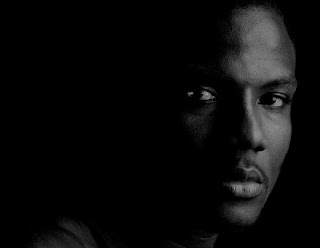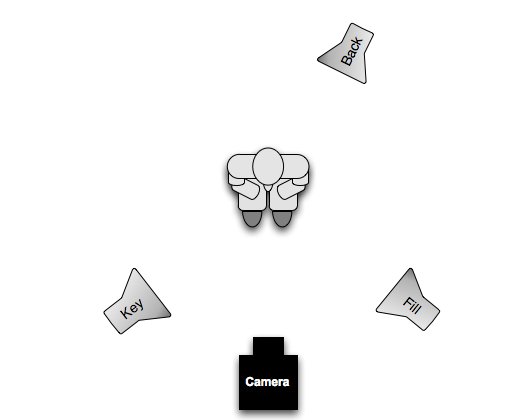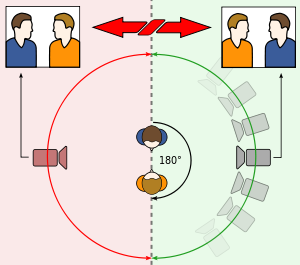The main purpose of lighting is to make sure that the camera can see the subject. it is also valuable to give information about: Characters,Setting and mood.
There are basically six types of lighting used in film and television

An example of high key lighting being mostly light colours
High-Key lighting- A style of lighting highlights bright, even illumination,with few obvious shadows. Uses primarily soft light.

An example of low-key lighting being mostly dark colours
Low-Key lighting - A style of lighting that highlights diffused shadows and atnospheric pools of light. Sometimes called chiaroscuro.Italian for light(chiaro) and dark(oscuro). Uses primarily hard light.

This shows how light from an unrelatable source can be effective if its behind an important subject(like green arrow in this scene who is clearly dark but the light helps you see him properly).
Back-lighting - When the lights for a shot derive from the rear of the set, thus throwing the foreground figures into semi-darkness or silhouette.

This shows an example of available light, with light sources in different areas of the human hand.
Available light- light sources already available in a location e.g. the sun or street lamps. Film and Television crews will use Reflectors to enhance available light.

An example showing how three-point lighting works
Three- point lighting - normally used in the studio set-up is as follows
In a studio , the lighting is usually from three main sources(as shown on top image)
1) The key light, as the name suggests, is usually the brightest and the most influential
2) The back light, helps counteract the effect of the key light, also making the characters or objects look more rounded.
3)the filler light helps to soften the harsh shadows that the use of key and back lights create(could be more than one filler light).
The line of action
For understanding the net effect of multiple forces applied to a body
Composition people

Composition: The arrangement of elements within the frame
Framing: the choice of where to put the camera in an given environment
Rule of thirds: dividing the frames into equal proportions can be dull but if you use the thirds of divide into 2:3 or 3:5 ratios you can achieve a far more pleasing balance.
The 180 rule/line of action

This schematic(ON TOP) shows the axis between two characters and the 180° arc on which cameras may be positioned (green). When cutting from the green arc to the red arc, the characters switch places on the screen.
Shot types

This shows all the different types of camera shots Types that ate done in filming which are used for filming different shots out.
Sound

sound has been used to enhance visual experience of film and the lesser extent of television.
Silent cinema ( 1890 - 1927 ) used live music (piano ,organ , full orchestra)
1927 Warner brothers released first film with soundtrack the jazz singer.
2001 Digital synchronized soundtrack combining the elements of dialogue, music and SFX
Diegetic
An example of diegetic sound in this scene at 0:13 were you hear (bar music) used as part of the film.
Refers to elements of a film that originate directly from within the TV narrative. For example, a popular song that is being played on the soundtrack would be diegetic if it was clear that it was coming from a source within the world of film, such as car radio.
Non-Diegetic
This shows one of the examples of non-diegetic sound, which can be used in credits with music(shown on top)
It refers to any elements that remain outside the world of the TV , such as voice over, credits and mood setting music that does not directly originate from the world of the TV.
soundtracks are equally 'sound images', constructed and selected much the same way as the visual images created.
Overlapping dialogue
From this clip overlapping dialogue is used in 0:23 to 0:26,(were someone else is talking but the filmmaker doesn't show his face).
Can be ending a scene by including dialogue from the next scene, then dissolving into that conversation, is a decision for the TV editor and the director .
Voice over

An image showing partly how actors create there voice overs with a microphone
While seemingly a useful device to accelerate storytelling, to comment on the action, and to admit us into the thoughts of the protagonist in a way novelist or a narrator are rarely used in TV series.
music
This is one ending scene of hollyoaks, which combines dramatic music to convey danger
Primarily used to inform the audience of appropriate emotional responses, or having established a response , to enhance it. For example . stirring strings during a heterosexual embrace. music is often seen as the final track as a way of anchoring meaning, eliminating ambiguities of spectator response.
It can be used at the editing stage as a rhythmic device to inform the pace of cutting.
Music appears to give us a direct access to the emotions of the characters.
sound effects

http://www.youtube.com/watch?v=fbDFAaPfl28
This movie clip shows a range of sound effects from living things to objects.
Normally perceived as part of narrative realism ,authenticating the images and informing the narrative attention, this is used to evoke mood of scenery or characters.
biolography
http://samjonesmediaexam.blogspot.co.uk/2012/10/shot-types.html
http://www.storymastery.com/misdemeanors/105-overlapping-dialogue
www.youtube.com
www.moodle2.com
No comments:
Post a Comment